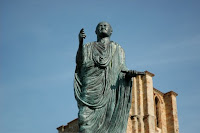The South of Spain is rich with Roman sites, from hidden paths to entire towns. Many of the more prominent ruins, such as Baelo Claudia, Italica and Acinipio are open to the public and well worth a visit. Some, such as Baelo Claudia, have excellent interpretation centres.
As part of the Roman struggle against Carthage, they invaded the Iberian peninsula in 206 BC. Scipio Africanus was victorious at Alcalá del Rio near present day Seville and founded the city Italica and his army crushed the resistance of the native Iberians and soon transformed Andalucia into one of Rome's richest and best organised colonies. Cadiz became Roman in 200 BC. The Romans remained for 700 years.
Rome divided Spain into two. Hispania Citerior was to them Nearer Spain (the East) and Hispania Ulterior (Further Spain) the South and West.
Roman galleys sailed up the river Baetis as far as Cordoba, where they took on board amphorae of olive oil and wine for exportation to Rome.
Julius Ceasar was promoted to Governor of Hispania Ulterior (Spain) in BC 61.
Seneca the elder was born in Cordubu in BC 55 and in AD65 his son Seneca the younger committed suicide after plotting against Emperor Nero.
In AD27 the Emperor Augustus renamed much of Ulterior - 'Baetica'. The name was taken from the River Baetis (now Guadalquivir) provinces. This region corresponded to roughly what is now Andalucia. Corduba was the capital.
In AD 69 the Emperor Vispasian who was born at Italica granted Roman status to all the towns in Hispania.
Trajan who was born at Italica is ruled as Emperor of Rome from 98 to 117 AD.
Things started to change with the spread of Christianity from the first to the forth century. St.Paul had identified Spain as a target for conversion in his Episple to the Romans. He toured Spain in AD 62.
The Spanish Bishops held their first open Council at Elvira in AD 300. The Emperor Diocletian instituted their last ruthless persecution in AD 303. As Spain became a Christian country, and the Spanish language - perhaps the closest modern tongue to Latin - began to take its current shape.
The Roman Route of Andalucía or as it is known in Spanish, the Ruta Baetica Romana comes from the historic regional name for the province. Today, the Roman Route includes 14 cities within the provinces of Seville, Cadiz and Cordoba and includes areas of great natural and geographical importance.
https://goo.gl/EWzmMN



No comments:
Post a Comment